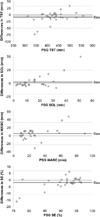Measures of sleep and cardiac functioning during sleep using a multi-sensory commercially-available wristband in adolescents
- PMID: 26969518
- PMCID: PMC5498752
- DOI: 10.1016/j.physbeh.2016.03.006
Measures of sleep and cardiac functioning during sleep using a multi-sensory commercially-available wristband in adolescents
Abstract
To validate measures of sleep and heart rate (HR) during sleep generated by a commercially-available activity tracker against those derived from polysomnography (PSG) in healthy adolescents. Sleep data were concurrently recorded using FitbitChargeHR™ and PSG, including electrocardiography (ECG), during an overnight laboratory sleep recording in 32 healthy adolescents (15 females; age, mean±SD: 17.3±2.5years). Sleep and HR measures were compared between FitbitChargeHR™ and PSG using paired t-tests and Bland-Altman plots. Epoch-by-epoch analysis showed that FitbitChargeHR™ had high overall accuracy (91%), high sensitivity (97%) in detecting sleep, and poor specificity (42%) in detecting wake on a min-to-min basis. On average, FitbitChargeHR™ significantly but negligibly overestimated total sleep time by 8min and sleep efficiency by 1.8%, and underestimated wake after sleep onset by 5.6min (p<0.05). Within FitbitChargeHR™ epochs of sleep, the average HR was 59.3±7.5bpm, which was significantly but negligibly lower than that calculated from ECG (60.2±7.6bpm, p<0.001), with no change in mean discrepancies throughout the night. FitbitChargeHR™ showed good agreement with PSG and ECG in measuring sleep and HR during sleep, supporting its use in assessing sleep and cardiac function in healthy adolescents. Further validation is needed to assess its reliability over prolonged periods of time in ecological settings and in clinical populations.
Keywords: Actigraphy; Adolescence; Fitbit; Heart rate; Polysomnography; Wearables.
Copyright © 2016 Elsevier Inc. All rights reserved.
Figures



References
-
- McKnight-Eily L, Eaton D, Lowry R, Croft J, Presley-Cantrell L, Perry G. Relationships between hours of sleep and health-risk behaviors in US adolescent students. Prev Med. 2011;53:271–273. - PubMed
-
- Silvetti M, Drago F, Ragonese P. Heart rate variability in healthy children and adolescents is partially related to age and gender. Int J Cardiol. 2001;81:169–174. - PubMed
MeSH terms
Grants and funding
LinkOut - more resources
Full Text Sources
Other Literature Sources
Medical

